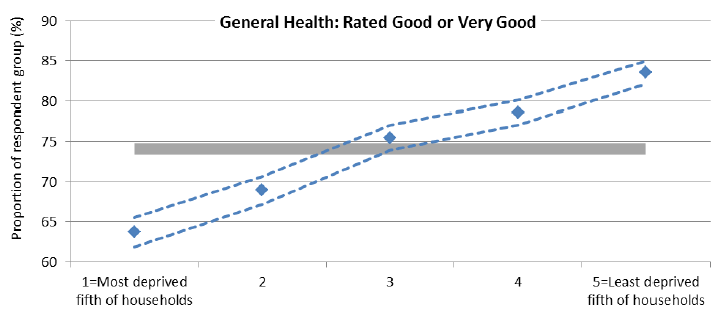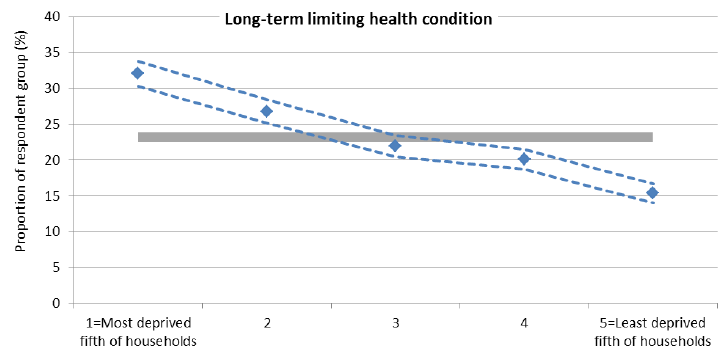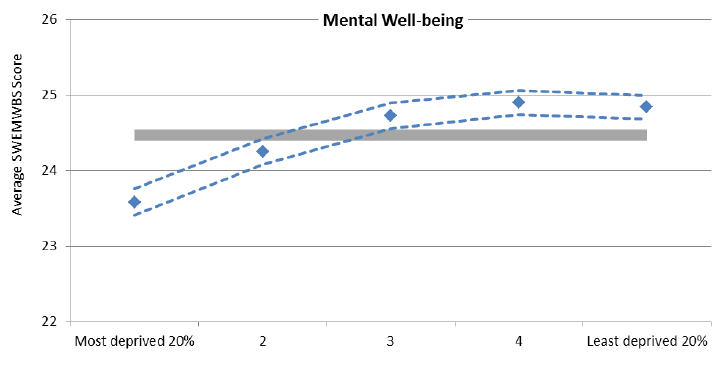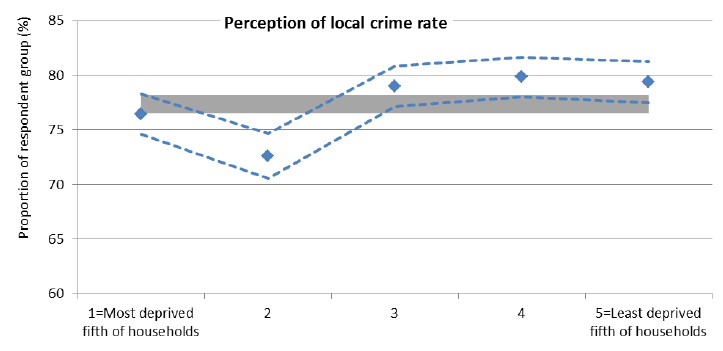Scottish Surveys Core Questions 2014
Official statistics publication on equality groups across a range of measures from harmonised questions across the major SG population surveys.
8 Deprivation
The Scottish Index of Multiple Deprivation ( SIMD) is the Scottish Government's official tool for identifying concentrations of deprivation. It incorporates several different aspects of deprivation, combining them into a single index. It divides Scotland into 6,505 small areas, called datazones, each containing around 350 households or around 800 people.
The Index provides a relative ranking for each datazone, from 1 (most deprived) to 6,505 (least deprived). By identifying small areas where there are concentrations of multiple deprivation, the SIMD can be used to target policies and resources at the places with greatest need. [46]
The SIMD cannot be used to determine 'how much' more deprived one data zone is than another e.g. it is not possible to say that data zone X, ranked 50, is twice as deprived as data zone Y, ranked 100. For the purposes of this analysis, the population is split into quintiles - groups comprising 20% of SIMD areas - based on deprivation rank. Note that area deprivation identifies areas of concentrated deprivation, but people experiencing deprivation can live outside these areas.
Deprivation is not a protected equality characteristic per se. However it is strongly correlated with a number of indicators examined throughout this report, and interactions between equality groups and deprivation area are likely to be important in understanding inequality. For this reason, the distribution of protected characteristic subgroups discussed in previous chapters is provided in Table 69.
Summary Findings
- Adults in more deprived areas have lower levels of good/very good general health than in less deprived areas, higher proportions with long-term limiting health conditions and higher smoking prevalence.
- Between deprivation quintiles 1-3 (the most deprived 20% through to the middle deprivation group) mental wellbeing increases. Between the 3 rd and 5 th quintile groups (the middle to the least deprived areas) there is no statistically significant difference.
- Adults in the second most deprived group are less likely to report that crime in their area has reduced or stayed the same in the last two years. Other deprivation area groups do not differ significantly from the national average level. This represents a large change for people in the most deprived 20% of areas, where this indicator has increased 7.1 percentage points since 2012.
Table 69 shows that the following subgroups are more likely to live in the most deprived areas than the Scottish population as a whole:
- Younger adults (under 35)
- People with long-term limiting health conditions
- White: Polish and "All other" ethnic groups
- Roman Catholics
- LGB & Other
- Those born in the EU outside the UK
Table 69: Deprivation distribution of protected equality groups, SSCQ 2014 [47]
| Scottish Index of Multiple Deprivation - Quintiles (row %) |
|||||||||||
|---|---|---|---|---|---|---|---|---|---|---|---|
| Most deprived 20% |
2 |
3 |
4 |
Least deprived 20% |
|||||||
| All |
19.8 |
± 0.9 |
19.6 |
± 0.8 |
19.9 |
± 0.8 |
21.0 |
± 0.9 |
19.7 |
± 0.9 |
|
| Respondent Age Group |
|||||||||||
| 16-24 |
23.8 |
± 2.6 |
20.4 |
± 2.4 |
18.1 |
± 2.3 |
18.0 |
± 2.4 |
19.7 |
± 2.6 |
|
| 25-34 |
24.4 |
± 2.1 |
21.7 |
± 1.9 |
19.8 |
± 1.9 |
17.8 |
± 1.9 |
16.2 |
± 1.8 |
|
| 35-44 |
19.5 |
± 1.8 |
20.2 |
± 1.8 |
19.8 |
± 1.7 |
20.8 |
± 1.8 |
19.6 |
± 1.8 |
|
| 45-54 |
18.6 |
± 1.6 |
18.9 |
± 1.6 |
19.3 |
± 1.6 |
23.2 |
± 1.8 |
20.0 |
± 1.7 |
|
| 55-64 |
17.4 |
± 1.5 |
17.4 |
± 1.5 |
22.0 |
± 1.7 |
21.5 |
± 1.7 |
21.7 |
± 1.8 |
|
| 65-74 |
16.5 |
± 1.6 |
18.8 |
± 1.6 |
21.6 |
± 1.8 |
23.9 |
± 1.9 |
19.3 |
± 1.7 |
|
| 75+ |
17.0 |
± 1.7 |
19.8 |
± 1.9 |
18.7 |
± 1.8 |
22.0 |
± 2.0 |
22.4 |
± 2.1 |
|
| Limiting Long-term Physical or Mental Health Condition |
|||||||||||
| Yes |
27.3 |
± 1.7 |
22.6 |
± 1.5 |
18.8 |
± 1.3 |
18.2 |
± 1.4 |
13.0 |
± 1.3 |
|
| No |
17.5 |
± 0.9 |
18.7 |
± 0.9 |
20.3 |
± 0.9 |
21.9 |
± 1.0 |
21.7 |
± 1.0 |
|
| Ethnic Group |
|||||||||||
| White: Scottish |
20.6 |
± 1.0 |
20.6 |
± 0.9 |
19.9 |
± 0.9 |
20.4 |
± 0.9 |
18.5 |
± 1.0 |
|
| White: Other British |
12.0 |
± 1.6 |
14.2 |
± 1.7 |
21.3 |
± 2.0 |
26.9 |
± 2.2 |
25.6 |
± 2.2 |
|
| White: Polish |
43.1 |
± 7.4 |
20.9 |
± 5.9 |
15.6 |
± 4.9 |
11.1 |
± 4.6 |
9.3 |
± 4.5 |
|
| White: Other |
13.6 |
± 3.0 |
16.2 |
± 3.4 |
21.2 |
± 3.8 |
21.2 |
± 3.9 |
27.7 |
± 4.8 |
|
| Asian |
19.4 |
± 5.3 |
24.6 |
± 5.8 |
15.2 |
± 4.9 |
16.1 |
± 4.7 |
24.6 |
± 6.0 |
|
| All other ethnic groups |
35.5 |
± 7.8 |
15.9 |
± 5.7 |
14.5 |
± 6.0 |
18.7 |
± 7.2 |
15.5 |
± 5.4 |
|
| Religion |
|||||||||||
| None |
19.0 |
± 1.1 |
20.0 |
± 1.2 |
20.1 |
± 1.1 |
21.2 |
± 1.2 |
19.7 |
± 1.3 |
|
| Church of Scotland |
17.3 |
± 1.3 |
18.4 |
± 1.2 |
20.1 |
± 1.3 |
23.2 |
± 1.4 |
21.1 |
± 1.4 |
|
| Roman Catholic |
28.9 |
± 2.3 |
22.2 |
± 1.9 |
18.8 |
± 1.9 |
14.7 |
± 1.7 |
15.4 |
± 1.8 |
|
| Other Christian |
15.3 |
± 2.4 |
15.5 |
± 2.3 |
20.6 |
± 2.5 |
25.3 |
± 2.9 |
23.4 |
± 2.8 |
|
| Muslim |
24.0 |
± 6.9 |
25.5 |
± 7.5 |
19.8 |
± 7.3 |
14.5 |
± 6.2 |
16.2 |
± 6.2 |
|
| Other |
19.3 |
± 5.5 |
20.6 |
± 6.1 |
15.9 |
± 4.9 |
18.9 |
± 5.1 |
25.3 |
± 6.3 |
|
| Sexual Orientation |
|||||||||||
| Heterosexual |
19.5 |
± 0.8 |
19.5 |
± 0.8 |
19.9 |
± 0.8 |
21.2 |
± 0.8 |
19.9 |
± 0.9 |
|
| LGB & other |
31.8 |
± 6.6 |
22.4 |
± 5.6 |
14.6 |
± 5.0 |
15.1 |
± 4.6 |
16.0 |
± 5.4 |
|
| Country of Birth |
|||||||||||
| Scotland |
20.7 |
± 1.0 |
20.4 |
± 0.9 |
20.0 |
± 0.9 |
20.4 |
± 0.9 |
18.6 |
± 1.0 |
|
| Rest of UK |
10.8 |
± 1.7 |
13.7 |
± 1.8 |
21.6 |
± 2.1 |
28.3 |
± 2.4 |
25.6 |
± 2.4 |
|
| Rest of EU |
26.4 |
± 4.0 |
19.2 |
± 3.6 |
20.4 |
± 3.5 |
16.8 |
± 3.4 |
17.1 |
± 3.4 |
|
| Rest of World |
19.9 |
± 3.5 |
20.8 |
± 3.6 |
14.2 |
± 3.0 |
18.1 |
± 3.4 |
27.0 |
± 4.6 |
|
As shown in Table 70, the age profiles of the SIMD quintile groups is somewhat different. In general there are higher proportions of younger adults in more deprived areas. For this reason, age standardisation is undertaken to check that apparent differences cannot be explained solely by this demographic effect. For more information on this process, see section 11.10.
Table 70: Age profile of deprivation quintile groups, SSCQ 2014
|
|
Proportion in Age Group (Row %) |
Adults |
Col% |
|||||
|---|---|---|---|---|---|---|---|---|
| 16-24 |
25-34 |
35-44 |
45-54 |
55-64 |
65+ |
|||
| Most deprived 20% |
16.8 |
19.5 |
15.0 |
17.0 |
13.3 |
18.5 |
877,600 |
20% |
| 2 |
14.6 |
17.5 |
15.7 |
17.4 |
13.4 |
21.4 |
869,900 |
20% |
| 3 |
12.7 |
15.7 |
15.2 |
17.5 |
16.7 |
22.2 |
883,700 |
20% |
| 4 |
12.0 |
13.4 |
15.1 |
20.0 |
15.5 |
24.0 |
931,000 |
21% |
| Least deprived 20% |
14.0 |
13.0 |
15.1 |
18.4 |
16.6 |
22.9 |
874,200 |
20% |
Throughout this chapter, statistical testing is used to identify differences between subgroups. For this purpose, the median deprivation group - group 3 - is used as the basis for comparison. Where p-values are provided, a value of less than 0.05 indicates statistical significance at the 95% level. For more information about statistical tests, see section 11.11.
8.1 General Health
Figure 19: General health by deprivation, SSCQ 2014

There is a very clear correlation between self-assessed general health and deprivation, ranging from 63.7% in the most deprived fifth of areas reporting good or very good health and 83.6% in the least deprived fifth of areas.
Table 71: General health by deprivation, SSCQ 2014; changes from 2013 and 2012
| 2014 |
Change |
||||
|---|---|---|---|---|---|
| grp % |
+/- |
from 2013 |
from 2012 |
||
| SIMD |
Most deprived 20% |
63.7 |
± 1.8 |
+0.2 |
+2.4 |
| 2 |
69.0 |
± 1.7 |
+0.3 |
-0.4 | |
| 3 |
75.5 |
± 1.6 |
-0.4 |
+0.0 | |
| 4 |
78.6 |
± 1.5 |
-2.7 |
-0.0 | |
| Least deprived 20% |
83.5 |
± 1.4 |
-0.7 |
+0.2 | |
The minor adjustments to this relationship by age standardisation only accentuate the underlying differences, due to a younger population in more deprived areas and an older population in the less deprived areas. If the most deprived 20% of areas had the same age distribution as Scotland as a whole just 61.5% would rate their health "good" or "very good", compared with around 74% in Scotland as a whole.
Table 72: Proportions rating general health "Good" or "Very good" - age standardised SIMD quintile results, SSCQ 2014
|
|
Base level |
Age standardised |
|
|---|---|---|---|
| Most deprived 20% |
63.7% |
61.5% |
± 1.8 |
| 2 |
69.0% |
68.3% |
± 1.8 |
| 3 |
75.5% |
75.8% |
± 1.6 |
| 4 |
78.6% |
79.3% |
± 1.5 |
| Least Deprived 20% | 83.5% | 84.2% | ± 1.4 |
8.2 Long-term Limiting Health Conditions
There is a very clear correlation between deprivation and long-term limiting health conditions. The rate in the least deprived fifth of areas is around half that in the most deprived fifth of areas (15.3% compared with 32.0%).
In general as deprivation increases, so does the rate of long-term limiting health conditions. The rates in the median group and the 4 th quintile are not significantly different. The rate in the 4 th quintile group has increased by a statistically signfiicant marginal from 2013, up 3.3 points from 16.8% to 20.1% in 2014.
Accounting for the age differences in area deprivation does not affect the differences between groups despite a somewhat younger population in the most deprived areas.
Figure 20: Long-term limiting health conditions and deprivation, SSCQ 2014

Table 73: Long-term limiting health conditions by deprivation, SSCQ 2014; changes from 2013 and 2012
| 2014 |
Change |
|||||
|---|---|---|---|---|---|---|
| grp % |
+/- |
from 2013 |
from 2012 |
|||
| SIMD |
Most deprived 20% |
32.0 |
± 1.7 |
+0.5 |
-2.1 |
|
| 2 |
26.8 |
± 1.6 |
-0.8 |
-0.7 |
||
| 3 |
21.9 |
± 1.5 |
+0.0 |
-0.6 |
||
| 4 |
20.1 |
± 1.4 |
+3.3 |
|
+0.3 |
|
| Least deprived 20% |
15.3 |
± 1.3 |
+0.3 |
-0.8 |
||
8.3 Smoking
There is a clear correlation between deprivation and smoking; adults in the most deprived areas are more than three times as likely to smoke than in the least deprived areas. The smoking rate in most deprived group fell 3.3 percentage points from 2013 and a further 0.6 points from 2012. The highest reduction over the series is in the median group, which has fallen from 23.2% in 2012 to 18.6% in 2014; a reduction of almost one fifth.
Table 74: Smoking prevalence by deprivation, SSCQ 2014; changes from 2013 and 2012
| 2014 |
Change |
||||||
|---|---|---|---|---|---|---|---|
| grp % |
+/- |
from 2013 |
from 2012 |
||||
| SIMD |
Most deprived 20% |
34.5 |
± 1.8 |
-3.3 |
|
-3.9 |
|
| 2 |
27.6 |
± 1.7 |
+0.3 |
-1.1 |
|||
| 3 |
18.6 |
± 1.5 |
-3.1 |
|
-4.6 |
|
|
| 4 |
15.4 |
± 1.4 |
-1.0 |
-2.1 |
|
||
| Least deprived 20% |
10.2 |
± 1.2 |
-0.6 |
-1.3 |
|||
8.4 Mental Wellbeing
Figure 21: Average SWEMWBS score by deprivation, SSCQ 2014

Deprivation appears to have a clear link to mental wellbeing. Those in the most deprived 20% of areas have the lowest average scores at 23.6.
The next most deprived group is 0.7 points higher and the median group is 0.4 points higher still at 24.7.
However there is no significant difference between the median group and individuals in the least deprived 40% of areas; the top three groups score around 24.8 on average.
Table 75: Average SWEMWBS score by deprivation, 2014
| 2014 |
|||
|---|---|---|---|
| Mean |
+/- |
||
| SIMD |
Most deprived 20% |
23.6 |
± 0.2 |
| 2 |
24.3 |
± 0.2 |
|
| 3 |
24.7 |
± 0.2 |
|
| 4 |
24.9 |
± 0.2 |
|
| Least deprived 20% |
24.8 |
± 0.2 |
|
8.5 Provision of Unpaid Care
There is no difference in the rate of upaid care provision between any of the deprivation groups and the national average. Age standardisation has no effect on this relationship.
Table 76: Provision of unpaid care by deprivation, SSCQ 2014
| 2014 |
|||
|---|---|---|---|
| grp % |
+/- |
||
| SIMD |
Most deprived 20% |
17.6 |
± 1.6 |
| 2 |
18.6 |
± 1.7 |
|
| 3 |
17.5 |
± 1.5 |
|
| 4 |
17.8 |
± 1.5 |
|
| Least deprived 20% |
17.9 |
± 1.6 |
|
8.6 Perceptions of Local Crime Rate
Adults in the second most deprived group are less likely to report that crime in their area has reduced or stayed the same in the last two years. Other deprivation area groups do not differ significantly from the national average level.
This represents a change from the position in 2012 and 2013, when the most deprived group also scored lower than the national average on this indicator. Adults in the most deprived 20% of areas have reported a consistent increase in this indicator over three years, up 7.1 percentage points from 2012, and 3.4 points from 2013.
Since 2012, the median deprivation group has reported a rise of 3 percentage points in this indicator. However the median group does not differ from the national average rate throughout the time series.
Table 77: Local crime rate by deprivation, SSCQ 2014; changes from 2013 and 2012
| 2014 |
Change |
||||||
|---|---|---|---|---|---|---|---|
| grp % |
+/- |
from 2013 |
from 2012 |
||||
| SIMD |
Most deprived 20% |
76.4 |
± 1.8 |
+3.4 |
 |
+7.1 |
|
| 2 |
72.6 |
± 2.1 |
-1.3 |
+0.4 |
|||
| 3 |
79.0 |
± 1.8 |
+0.9 |
+3.0 |
|
||
| 4 |
79.9 |
± 1.8 |
-0.5 |
+0.4 |
|||
| Least deprived 20% |
79.4 |
± 1.9 |
-2.4 |
-2.0 |
|||
Figure 22: Local crime rate by deprivation, SSCQ 2014

8.7 Confidence in Policing
Analysis of Confidence in Police is conducted on latent classes across all six questions. These statistics are in development and are therefore provided in a supplementary paper available from the SSCQ website. [48]
Contact
There is a problem
Thanks for your feedback
